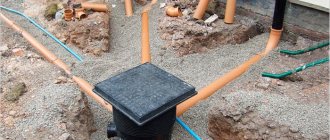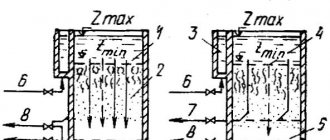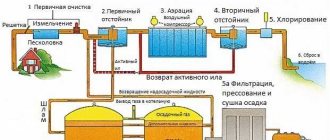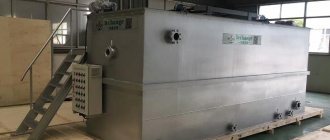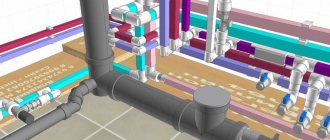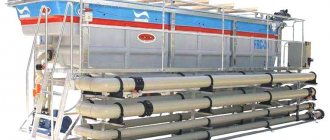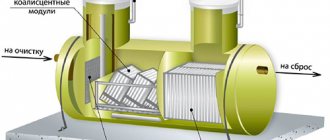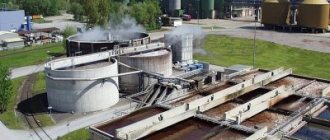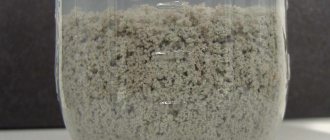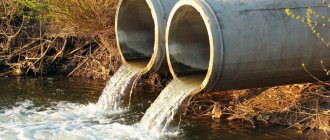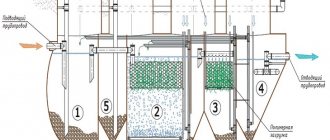Pollution of the World Ocean today is one of the global environmental problems of humanity. The mountain of garbage in the Pacific Ocean has reached such a large size that it has become known as the “garbage continent.” At the same time, solid household waste is far from the only source of pollution of the world’s oceans. A significant contribution to the pollution of aquatic ecosystems is made by wastewater from enterprises.
For example, the Baikal Pulp and Paper Mill discharged industrial waste into Lake Baikal, where 20% of the world's fresh water reserves are concentrated, for a long period of time (from 1966 to 2013), which significantly deteriorated the quality of water in the lake. Factories that produce food, cars or plastic also cause enormous harm to the environment.
Today, liquid waste from enterprises has become the main source of water pollution. In this article we will look at changes in the composition of water after its use at an enterprise, types of regulation of industrial discharges, as well as methods for their purification. In addition, you will learn what the danger of industrial discharges is for reservoirs and what to do if there are suspicions that an unauthorized discharge is being made into the reservoir that you use for swimming, or into the area near which your well or borehole is located. industrial waste.
Definition
Enterprise wastewater includes water that, after being used in the industrial cycle, is contaminated with production waste.
Almost every industry uses water in its production process, which contaminates it with waste and can change its physical characteristics, such as temperature. Nowadays, in modern enterprises, wastewater is divided into categories according to composition, according to the conditions of disposal and treatment, as well as further use in a closed water supply cycle.
Damage from wastewater discharge
In accordance with Art. Article 77, 78 of the Federal Law of the Russian Federation of January 10, 2002. No. 7-FZ “On Environmental Protection”, Part 1 of Art. 69 of the Water Code of the Russian Federation of June 3, 2006 No. 74-FZ, legal entities that have caused harm to the environment as a result of its pollution are obliged to compensate it in full in accordance with environmental legislation; Determination of the amount of damage to the environment caused by violation of legislation in the field of environmental protection is carried out based on the actual costs of restoring the disturbed state of the environment, taking into account the losses incurred, including lost profits, as well as in accordance with projects for reclamation and other restoration work, in their absence, in accordance with the rates and methods for calculating the amount of damage to the environment, approved by executive authorities exercising public administration in the field of environmental protection
The calculation of damage is made on the basis of the Methodology for calculating the amount of damage, approved by the Ministry of Natural Resources of Russia dated April 13, 2009 No. 87.
Compensation for environmental damage caused by violation of environmental legislation is carried out voluntarily or by decision of a court or arbitration court
Article 78 of the Federal Law of January 10, 2002 No. 7-FZ “On Environmental Protection”
Thus, if your company is affected by this situation, then you:
- will offer to voluntarily pay for the damage; we will provide you with a calculation of the damage with a covering letter;
- If you fail to pay on time, your business will be subject to a claim for compensation for environmental damage caused by violation of environmental laws.
Compound
In water, industrial waste forms complex multicomponent mixtures that are difficult to remove. The nature of pollution from discharges depends on the industry and the materials processed. For a clear example, here is a table of the composition of discharges from various enterprises.
| Classification of wastewater from various enterprises | |
| Metallurgical industry | Mineral impurities, dust, dirt, sand, scale, oils, heavy metals, acids |
| Pulp and paper industry | Fibers, selenium, chlorine, sulfur dioxide, turpentine |
| Mechanical engineering industry | Petroleum products, phenols, suspended substances |
| Oil refining industry | Petroleum products, sulfates, suspended solids, chlorides |
| Poultry and meat processing plants | Nitrogen, phosphorus, potassium, viruses and bacteria |
| Fishing industry | Fats, vegetable oils, proteins, minerals |
| Oil industry | Hydrogen sulfide, paraffins, ammonia, mercaptans, sulfides, phenols, petroleum products, mineral salts, ammonium nitrogen |
| Plastic production | Phenols, plasticizers |
| Mining and processing industry | Heavy metals, acids, organic solvents |
| Coal industry | Suspended substances (coal dust and particles of associated rocks), petroleum products in the form of mineral oils |
| Textile industry | Mineral and organic impurities, reagents, detergents, fibers and suspended solids |
| Canned food production | Suspended solids, ammonium nitrogen, chlorides, sulfates, ether-soluble substances, phosphorus |
| Sugar and starch production | Nitrogen, potassium, calcium and phosphorus |
| Dairy industry | Milk serum |
MPC of wastewater
During the operation of industrial equipment, wastewater is generated with different characteristics
that require special treatment before being discharged into sewer systems. The most common pollutants in surface waters are petroleum products, phenols, easily oxidized organic substances, copper and zinc compounds, ammonium and nitrate nitrogen, lignin, potassium xanthate, aniline, methyl mercaptan, formaldehyde, etc. For example, wastewater from ferrous and non-ferrous metallurgy factories is contaminated a large amount of suspended minerals, contain non-ferrous metals and iron, sulfates, chlorides, resins and oils, sulfuric acid, ferrous sulfate. Oil refineries and oil fields discharge oil and oil products, chlorides, suspended solids, and possibly the presence of iron and hydrogen sulfide. Wastewater from coke-chemical plants poses a great danger: resins, oils, phenols, ammonia, cyanides, thiocyanates, large amounts of salts of inorganic acids and suspended substances. Heavily polluted wastewater that is difficult to treat includes liquid effluent from pulp and paper mills: dissolved organic substances, fiber, kaolin, etc. Machine-building and automobile factories discharge cyanide, chromium, oils and scale. The main pollutants of textile enterprises are dyes and anionic and nonionic surfactants (surfactants).
Table 1. Regional MPCs in the Russian Federation and the European Union
MPC of fishery water bodies and other water bodies is an amount that does not adversely affect human health with long-term, daily exposure. In this case, no pathological changes occur in the health of people of the living and subsequent generations, and also does not disturb the balance of the biocenosis in the reservoir.
Rationing
There are two fundamentally different scenarios for wastewater disposal:
- treated and untreated wastewater is discharged into storm or domestic sewers;
- treated wastewater is discharged into a reservoir or watercourse by a participant in economic activity.
In the first case, the use of water resources by enterprises is controlled by the Federal Law “On Water Supply and Sanitation”. All enterprises that discharge waste into water bodies or sewers must obtain permission from environmental authorities.
Based on Decree of the Government of the Russian Federation dated July 29, 2013 No. 644, maximum permissible concentrations (MAC) of harmful substances have been introduced for wastewater from enterprises, the excess of which is unacceptable.
| Indicator name | Unit change | MPC |
| Suspended solids | mg/dm3 | 300 |
| BOD5 | mg/dm3 | 300 |
| COD | mg/dm3 | 500 |
| Total nitrogen | mg/dm3 | 50 |
| General phosphorus | mg/dm3 | 12 |
| Petroleum products | mg/dm3 | 10 |
| Chlorine and chloramines | mg/dm3 | 5 |
| COD:BOD5 ratio | 2,5 | |
| Phenols | mg/dm3 | 5 |
| Sulfides | mg/dm3 | 1,5 |
| Sulfates | mg/dm3 | 1000 |
| Chlorides | mg/dm3 | 1000 |
| Aluminum | mg/dm3 | 5 |
| Iron | mg/dm3 | 5 |
| Manganese | mg/dm3 | 1 |
| Copper | mg/dm3 | 1 |
| Zinc | mg/dm3 | 1 |
| Chrome general | mg/dm3 | 0,5 |
| Chromium hexavalent | mg/dm3 | 0,05 |
| Nickel | mg/dm3 | 0,25 |
| Cadmium | mg/dm3 | 0,015 |
| Lead | mg/dm3 | 0,25 |
| Arsenic | mg/dm3 | 0,05 |
| Mercury | mg/dm3 | 0,005 |
| Hydrogen value (pH) | units | 6-9 |
| Temperature | ºC | +40 |
| Fats | mg/dm3 | 50 |
| Volatile organic compounds (VOCs) (including toluene, benzene, acetone, methanol, butanol, propanol, their isomers and alkyl derivatives by total VOCs) | mg/dm3 | 20 |
| Nonionic surfactants | mg/dm3 | 10 |
| Anionic surfactants | mg/dm3 | 10 |
| Polychlorinated biphenyls (total PCBs) | mg/dm3 | 0,001 |
Discharge of liquid waste is prohibited if it contains substances for which MPCs have not been developed. It is also prohibited to exceed the permitted volumes of wastewater discharges and discharge in unidentified places or in areas adjacent to treatment plants. If the maximum permissible concentration of pollutants in the waters discharged by an enterprise is exceeded, then it may be subject to a fine of up to 100,000 rubles or a ban on activities for up to 90 days.
In the second case, waste discharges from enterprises into water bodies are divided into slightly contaminated and polluted, which must be cleaned before being discharged into the water body. The level of pollution is determined by the concentration of impurities. If an enterprise discharges contaminated water into reservoirs or watercourses, then maximum permissible discharge standards are calculated for each enterprise, based on the quality of the water upstream of the discharge site and taking into account the volume of discharge. As a rule, such water requires purification or settling, even if used exclusively for cooling. Calculation of maximum permissible discharges (MPD) occurs on an individual basis.
MPC of petroleum products in wastewater
In their activities, many enterprises are forced to discharge contaminated water containing petroleum products. These are automobile enterprises, garages, service stations, car washes, as well as oil refining companies.
If such production facilities are located near water bodies where fish are bred, there is a risk of water pollution and death of animals. Therefore, maximum permissible concentrations for petroleum products in fishery water have been introduced.
Enterprises are required by law to organize the neutralization of contaminated water to the standards established by law.
Attention! For a list of acceptable wastewater indicators and the maximum concentration of pollutants in them, see the website Consultant.ru .
Cleaning methods
Pollution can be divided into:
- mechanical (insoluble particles);
- chemicals (toxic substances);
- bacterial (pathogenic bacteria and fungi);
- radiation (radioactive elements);
- physical (the state of aggregation of a substance or other characteristics, for example, temperature, has changed).
The choice of optimal treatment methods is possible only after quantitative analysis of wastewater. The degree of purification and the selection of effective equipment and filter elements depend on the composition of the pollution and the volume of wastewater.
Various methods and their combinations are used to purify industrial discharges. Straining, settling and filtration are mechanical cleaning methods. Filtration is the most common method of water purification. In metallurgy, up to 90% of insoluble contaminants are purified in this way. However, in the food industry, this method can remove no more than 5% of contaminants.
When applying physicochemical cleaning methods, I use precipitating reagents, electric current and temperature changes, freezing, and evaporation.
MPC of harmful substances
Maximum permissible concentrations of more than 960 chemical compounds have been established for water, which are grouped into three groups according to the following hazard indicators (LPH - limiting hazard indicator): sanitary-toxicological (s.-t.), general sanitary (general), organoleptic (org. ). Maximum concentration limits for some harmful substances in water bodies are presented in Table 2.
Table 2. Maximum concentrations of harmful substances in water bodies for domestic, drinking and cultural water use, mg/l
| Substance | LPV | MPC |
| Aluminum | S.-t. | 0,5 |
| Ammonia (by nitrogen) | Org. | 1,5 |
| Acetone | S.-t. | 2 |
| Benzpyrene | S.-t. | 0,000005 |
| Petrol | Org. | 0,1 |
| Bromine | S.-t. | 0,2 |
| Beryllium | S.-t. | 0,0002 |
| Bor | S.-t. | 0,5 |
| Bismuth | S.-t. | 0,1 |
| Benzene | S.-t. | 0,1 |
| Dimethylamine | Org. | 0,3 |
| Diethyl ether | Org. | 0,3 |
| Iron | Org. | 0,005 |
| Isoprene | General | 1,2 |
| Acetic acid | General | 0,1 |
| Synthetic fatty acids C5 - C20 | Org. | 0,1 |
| Manganese | Org. | 1 |
| Copper | S.-t. | 3 |
| Methanol | Org. | 0,1 |
| Oil | S.-t. | 0,0005 |
| Mercury | S.-t. | 0,03 |
| Lead | Org. | 1 |
| Carbon disulfide | General | absence |
| Sulfides | S.-t. | 0,05 |
| Formaldehyde | S.-t. | 0,0001 |
| Elemental phosphorus | General | 1 |
| Zinc | Org. | 0,5 |
| Ethylene | Org. | 0,5 |
| Molybdenum | S.-t. | 0,25 |
| Urea | General | 1 |
| Cadmium | S.-t. | 0,001 |
| Ethylene glycol | S.-t. | 1 |
Maximum permissible concentrations of harmful substances for fishery reservoirs and watercourses are established for 521 ingredients, grouped into groups according to the following LPs: toxicological, organoleptic, fishery and general sanitary. Water for drinking animals, according to standards, should not be inferior to the quality of drinking water, however, the requirements for organoleptic properties may be slightly reduced. Only in exceptional cases, in areas with a shortage of fresh water, in agreement with the sanitary-epidemiological service and veterinary supervision, is it allowed to use water of high mineralization for washing and watering animals, preparing feed and cleaning premises. The most stringent requirements must be placed on the condition of water used in livestock farming, since infection of animals through water and the development of epizootics cause enormous damage to the national economy.
It should be noted that the currently used methods for assessing water quality using the system of maximum permissible concentrations of pollutants do not provide a complete picture of the state of natural waters and are not a sufficient guarantee of their protection from pollution. The conditions under which the discharge of municipal and industrial wastewater into reservoirs and watercourses is possible are determined by the “Rules for the protection of surface waters from wastewater pollution” and the “Rules for the sanitary protection of coastal sea waters”, approved in 1974. But these rules are designed to ensure the purity of the reservoir only at the sites of drinking, cultural and household or fishery water use points. This approach has already led to the fact that many rivers in our country are polluted locally or continuously throughout almost their entire length. In stagnant and low-flowing reservoirs, self-purification processes proceed even more slowly and emergency situations often arise. Such phenomena occurred in Lake Ladoga, one of the sources of water supply for St. Petersburg, and in many large reservoirs. All modern treatment facilities are built using destructive treatment methods, which boil down to the destruction of water polluting substances through their oxidation, reduction, hydrolysis, decomposition, etc., and the decomposition products are partially removed from the water in the form of gases or sediments, and partially remain in it in the form of soluble mineral salts. As a result, so-called non-toxic mineral salts enter natural waters in quantities corresponding to the maximum permissible concentrations, but many times higher than their natural concentrations in the aquatic environment. Therefore, the discharge of wastewater into rivers and reservoirs, which has undergone deep purification from organic compounds of nitrogen, phosphorus, sulfur and other elements, nevertheless increases the content of soluble sulfates, phosphates, nitrates and other mineral salts in the water, causing eutrophication of reservoirs, their “blooming”. » due to the rapid development of blue-green algae; the latter, dying, absorb a lot of oxygen and deprive the water of its ability to self-purify.
Modern industry annually synthesizes many new substances; the establishment of their maximum permissible concentrations is inevitably delayed, especially since, when these substances enter water, they can create new, unexplored combinations of compounds with unknown properties.
Thus, the existing MPCs developed by the sanitary and hygienic service do not fully reflect the impact of alien substances on aquatic ecosystems.
Permitting documents for the discharge of industrial wastewater
If the enterprise being opened will cause harm to the environment as a result of its activities, it must obtain permitting documentation. To obtain a water use permit, an enterprise must have its wastewater analyzed in an accredited laboratory, where competent employees will take water samples for research. Sampling should be done after wastewater has passed through treatment facilities. Based on the results of the study, a protocol is formed, which indicates the content of harmful impurities. To obtain permission from Rosprirodnadzor, harmful substances in the protocol must not exceed the maximum permissible concentration. Also, a MAP norm is developed for each individual water user enterprise.
In addition to chemical analysis, the enterprise must:
- make an assessment of the amount of wastewater that must be removed from the enterprise in a certain unit of time;
- develop an action plan to reduce concentrations of harmful substances that negatively affect the environment;
- agree on the optimal discharge point for industrial waters;
- collect a complete package of permitting documents.
What has been developed and entered into force
The “Sanitary Rules and Norms for the Protection of Surface Waters from Pollution” came into effect. They describe the requirements for enterprises regarding the discharge of wastewater into rivers, reservoirs and lakes.
They are divided into two categories:
Number two must meet the standards at the point of release of contaminated water if it is equipped with a dispersal installation. If there is no such installation, then the wastewater should be clean no further than 500 meters from the outlet. At the same time, maximum permissible concentrations for fishery water must be observed.
The rules standardize several indicators of water purity:
- coloring;
- temperature;
- content of suspended and floating particles;
- taste;
- smell;
- pH value;
- dissolved oxygen;
- quantity and composition of mineral impurities;
- Maximum concentration limits and composition of harmful and hazardous substances;
- presence and composition of pathogenic bacterial strains.
For cultural, economic and drinking water bodies, maximum permissible concentrations have been established for more than 400 major hazardous substances. For fishery waters, maximum permissible concentrations for substances in fishery water have been developed; they are calculated for 100 elements and compounds.
